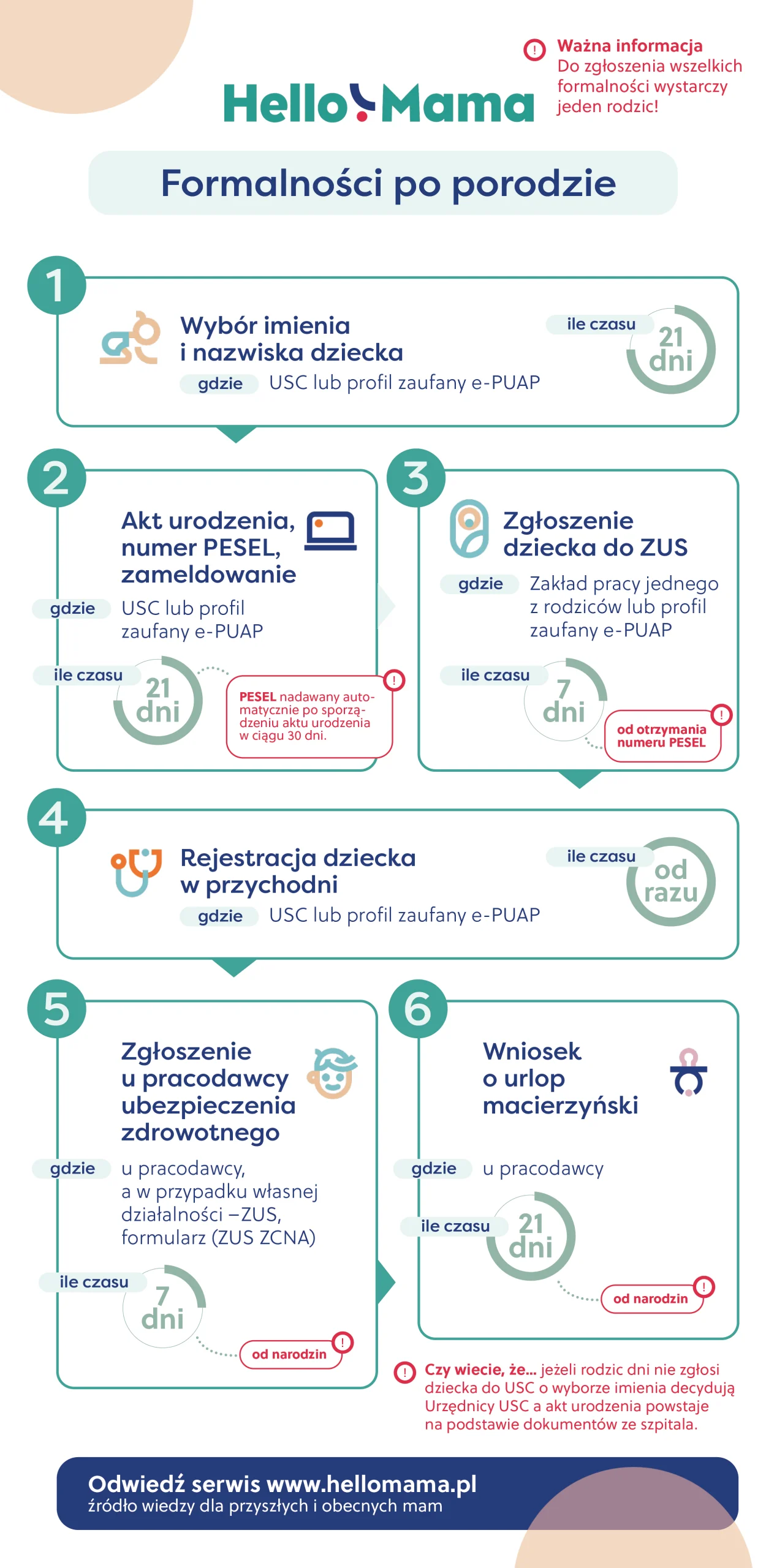
Spis treści:
Przed porodem – kiedy jechać do szpitala?
Wiele przyszłych mam bardzo obawia się, że poród je zaskoczy. Martwią się też, że przeoczą ważne znaki, że zbliża się ta chwila. Sytuacji nie ułatwiają pojawiające się czasem w mediach informacje np. o dziecku urodzonym w aucie na tylnym siedzeniu, bo rodząca nie dotarła na czas do szpitala. Statystycznie jest to jednak bardzo rzadka sytuacja. Poród (nie)stety rzadko ma tak szybki przebieg.
Dlatego odradza się podróż do szpitala, gdy tylko poczujesz pierwsze oznaki zbliżającego się porodu. Wydłużenie czasu spędzonego na oddziale porodowym może negatywnie wpływać na psychikę rodzącej. Jeśli np. za ścianą lub za kotarą rodzi inna kobieta, jej krzyk lub inne odgłosy związane z przebiegającym porodem mogą sprawić, że poczujesz się bardziej zestresowana niż powinnaś.
Termin porodu jest ustalany na podstawie daty ostatniej miesiączki. W rzeczywistości przewidywany termin porodu tylko w przypadku ok. 5 proc. kobiet się sprawdza. Dlatego o narodzinach w terminie mówi się w przypadku urodzenia dziecka na 2 tygodnie przed i na 2 tygodnie po prognozowanym terminie porodu. Innymi słowy, poród w terminie to poród między 38. a 42. tygodniem ciąży.
Te wskazania dotyczą ciąż pojedynczych. Ciąże mnogie kończą się zwykle wcześniej. Ciążę bliźniaczą uważa się za donoszoną po 36. tygodniu, a ciążę trojaczą – już po 34. tygodniu. Ciąże mnogie częściej są rozwiązywane przez cesarskie cięcie. Wymagają również dokładniejszego monitorowania przez personel medyczny. Dlatego nierzadko mamy wieloraczków spędzają w szpitalu więcej czasu przed porodem.
Jedź do szpitala, jeśli:
- czujesz regularne skurcze nie rzadziej niż co ok. 10 minut,
- odeszły wody płodowe.
Do szpitala należy się udać, nawet przed prognozowanym terminem porodu, jeśli:
- czujesz słabsze lub wyjątkowo gwałtowne ruchy płodu,
- czujesz silny nieprzerwany ból brzucha,
- krwawisz z dróg rodnych,
- masz wysoką gorączkę,
- masz silne bóle głowy,
- wody płodowe mają zabarwienie zielone lub brunatne.
Ile czasu trwa poród? To oczywiście indywidualna kwestia. Szacunkowo kolejne fazy porodu trwają:
- Okres rozwierania szyjki macicy – kilka do kilkunastu godzin,
- Poród właściwy – 30 do 120 minut,
- Rodzenie łożyska – 5 do 30 minut.
Następnie niezbędna jest ścisła obserwacja pacjentki przez 2 godziny po porodzie.
I okres porodu
Pierwszy okres porodu to okres rozwierania się szyjki macicy. Ten odcinek macicy łączy się z pochwą. W trakcie ciąży szyjka macicy pozostaje aż do porodu zamknięta. Następnie w trakcie postępującej akcji porodowej dochodzi do poszerzania szyjki macicy.
Szyjka macicy musi rozewrzeć się na tyle, aby głowa dziecka mogła się przez nią przecisnąć. Czaszka noworodka jest złożona z luźno połączonych kości. To ułatwia wyjście dziecka z dróg rodnych. Jednak szyjka macicy musi się w tym celu rozewrzeć aż do średnicy ok. 10 cm.
Dojrzewanie szyjki macicy oblicza się w palcach:
1 palec – to rozwarcie 2 cm, 2 palce – rozwarcie 4 cm, 3 palce – rozwarcie 6 cm, 4 palce rozwarcie 8 cm, 5 palców – pełne rozwarcie 10 cm.
Oprócz badania ginekologicznego palpacyjnego, można wykonać również transwaginalne USG.
Ocenę dojrzałości szyjki macicy podaje się w tzw. skali Bishopa. Punktuje się od 0 do 3 punktów następujące elementy:
- rozwarcie szyjki macicy,
- skrócenie szyjki macicy,
- konsystencję szyjki macicy,
- zaawansowanie części przodującej szyjki macicy,
- ułożenie szyjki macicy względem osi pochwy.
Jeśli suma punktów wynosi co najmniej 9, oznacza to dojrzałość szyjki macicy – niebawem nastąpi poród właściwy. Jeśli suma punktów wynosi co najmniej 11, oznacza to, że akcja porodowa już trwa.
Na tym etapie porodu skurcze pojawiają się co ok. 10 do 5 minut, trwają do 30 sekund.
Sukcesywnie skurcze pojawiają się coraz częściej i są coraz bardziej bolesne i długie – co 30 sekund do 1 minuty, trwają do 60 sekund. Taki skurcz błyskawicznie osiąga swój szczyt.
Najtrudniejszy moment dla rodzącej to „kryzys siódmego centymetra”, czyli moment, w którym rozwarcie wynosi właśnie ok. 7 cm. Wiele położnic na tym etapie traci wiarę w swoje siły i możliwości, może pojawić się obniżenie nastroju, a nawet złość na osoby w pobliżu. Narastający później poziom adrenaliny pomaga znieść dalsze trudy porodu. Gdy rozwarcie będzie pełne, ok. 10 cm, przechodzimy do kolejnej fazy porodu.
II okres porodu
Drugi okres porodu trwa od pełnego rozwarcia szyjki macicy do momentu narodzin noworodka. Trwa do ok. 2 godzin. U wieloródek ten etap zwykle przebiega szybciej.
W przypadku zastosowania znieczulenia zewnątrzoponowego może zdarzyć się, że ten okres porodu się przedłuży do ok. 3 godzin.
W drugim okresie porodu doświadczysz skurczy partych.
Powodują one sukcesywne przesuwanie się dziecka w dół kanału rodnego. Po skurczu dziecko cofa się z powrotem nieznacznie do góry. Dzięki temu tkanki szyjki macicy i pochwy są sukcesywnie rozciągane.
Ulżysz sobie, jeśli przed skurczem weźmiesz głęboki wdech. W trakcie skurczu szybko oddychaj. Po urodzeniu główki będziesz już bardzo blisko szczęśliwego zakończenia. Nadal szybko oddychaj lub uśmiechnij się. Zapewne już ostatni skurcz będzie potrzebny, aby wydać dziecko na świat.
Jeśli niezbędne okaże się nacinanie krocza, wbrew obawom rodzących, nie jest to bolesne. Zabieg wykonuje się, gdy w szczycie skurczu główka napiera na tkanki krocza. Są one wówczas rozciągnięte i niewrażliwe na ból.
Wbrew obawom wielu przyszłych mam, w trakcie porodu nie trzeba się zastanawiać, kiedy przeć. Gdy nadejdzie właściwy monet będziesz czuć nieopartą potrzebę parcia. Nie będziesz też zostawiona sama sobie. Wykwalifikowany personel będzie podpowiadał, co robić. Będzie również czuwać na prawidłowym przebiegiem porodu.
III okres porodu, czyli faza łożyskowa
Po przyjściu dziecka na świat, łożysko pozostaje na ścianie macicy. W ciągu kilku do kilkudziesięciu minut po narodzinach dziecka, kobieta rodzi również łożysko. Ponieważ jest ono miękkie, a kanał rodny jest już rozluźniony po przejściu dziecka, urodzenie łożyska nie przedstawia zwykle trudności.
Niezbędne jest sprawdzenie, czy łożysko wydalono w całości. Jeśli wewnątrz pozostaną niewydalone części łożyska, konieczne jest czyszczenie macicy (łyżeczkowanie). W przeciwnym razie może dojść do zakażenia organizmu, które może być zagrożeniem zdrowia i życia położnicy.
Po urodzeniu łożyska kobieta pozostaje jeszcze 2 godziny pod ścisłą opieką medyczną. Po porodzie zaczyna się szczególny czas połogu.
– Po porodzie siłami natury, szczególnie gdy było nacięcie lub pęknięcie krocza, powinno się wstawać przez klęk podparty (najpierw na bok, a następnie do klęku), by unikać siadania. I unikamy siadania – wiem, że to kontrowersyjne – przez dwa tygodnie po porodzie, bo nasze dno miednicy taki mniej więcej czas odzyskuje funkcję podtrzymania narządów – podpowiada fizjoterapeutka uroginekologiczna Joanna Kmieć-Nowakowska.
Pamiętaj, że przejście przez poród może być łatwiejsze, jeśli przed ciążą i w czasie ciąży (o ile nie ma medycznych przeciwwskazań) będziesz dbać o właściwą aktywność fizyczną. Jakie ćwiczenia najlepiej wesprą ciało kobiety w obliczu wyzwania, jakim jest poród?
– Regularna, umiarkowana, mieszana aktywność fizyczna – wymienia Joanna Kmieć – Nowakowska. – Czyli treningi aerobowe, siłowe oraz stretching i relaksacja – podpowiada specjalistka. – Sprawią, że ciało będzie gotowe na zmiany, jakie niesie ze sobą ciąża. Gdy kobieta czuje się dobrze i ginekolog stwierdzi, że ciąża rozwija się prawidłowo, to można kontynuować ćwiczenia w pierwszym trymestrze. Jednak muszą być one prowadzone z mniejszą intensywnością, z kontrolą tętna (do poziomu około 140 HR) i z odpowiednimi wariantami ćwiczeń mięśni brzucha (uelastyczniającymi, bez dużej tłoczni brzusznej). Sprawność w trakcie ciąży u większości kobiet gwarantuje sprawność po porodzie.
Joanna Kmieć-Nowakowska zwraca również uwagę, że tuż po porodzie możemy zacząć pracę nad powrotem do formy i figury sprzed ciąży – ale we właściwy sposób.
– Pierwsze ćwiczenia zalecane są jeszcze na etapie szpitalnym. Nikt nie mówi tu oczywiście o przeciążaniu się, tylko o ćwiczeniach oddechowych, przeciwzakrzepowych oraz jeśli kobieta czuje się dobrze, to o delikatnych napięciach kończyn dolnych i górnych. Nacelowane są one na poprawę krążenia, perystaltyki jelit oraz wspomaganie obkurczania macicy – wyjaśnia specjalistka.
Ekspertka Joanna Kmieć – Nowakowska – mgr fizjoterapii, prowadząca we Wrocławiu terapie dla kobiet Circa Feminae, fizjoterapeutka uroginekologiczna, trenerka personalna i instruktorka fitness.
Infografika formalności po porodzie





































